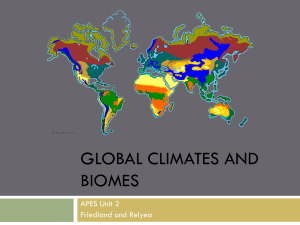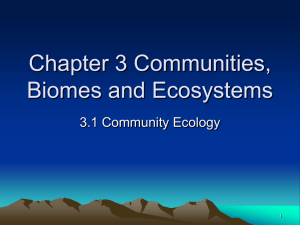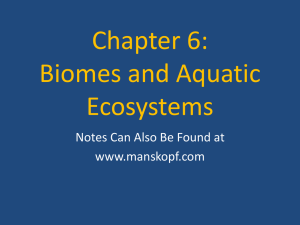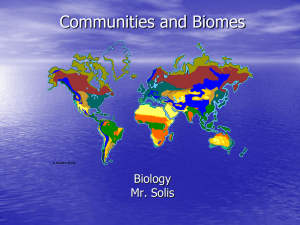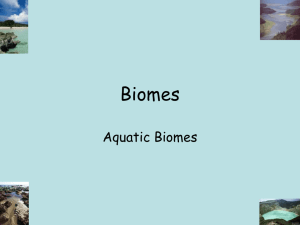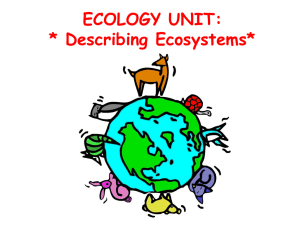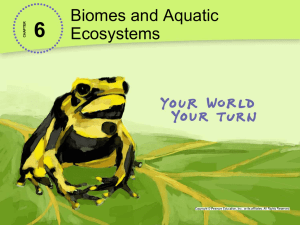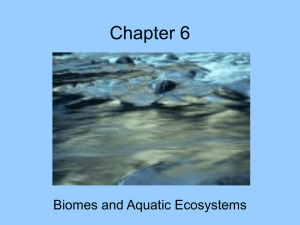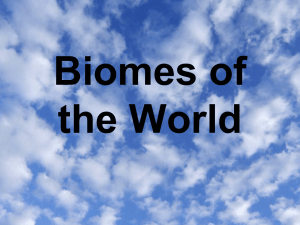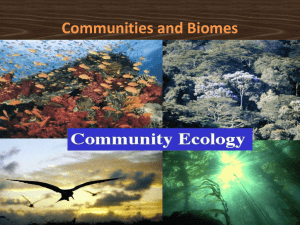Biomes and Aquatic Ecosystems Presentation
advertisement
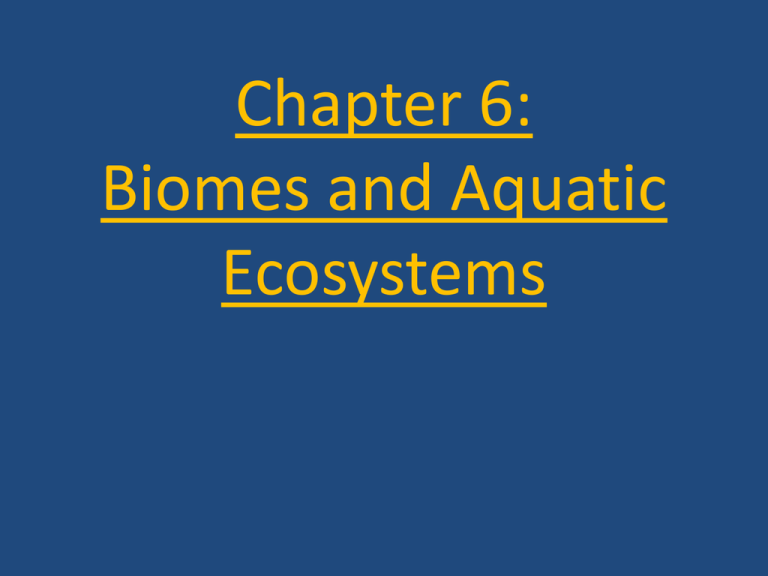
Chapter 6: Biomes and Aquatic Ecosystems 1. Explain how biomes are characterized 2. Describe how net primary production varies among biomes 3. Explain how organisms are adapted to the conditions of their biomes 4. Describe the criteria ecologist use to classify aquatic systems 5. List the major categories of freshwater ecosystems 6. Explain the ecological importance of estuaries 7. List the three major zones of the ocean 8. Define the following terms: biome, climate, weather, climatograph, net primary production, canopy, emergent layer, understory, epiphyte, deciduous, estivation, coniferous, hibernation, permafrost, salinity, photic zone, aphotic zone, benthic zone, littoral zone, limnetic zone, wetland, flood plain, estuary, upwelling, Chapter 6: 164-195 Do Now Turn IN 1.Explain in words and or a diagram the transition between winter and spring on the earth 2.and what it means for us in the Northern Hemisphere. 3.Do you know exactly what time spring starts? On March 20, there are twelve hours of daylight and twelve hours of darkness at all points on the earth's surface. Sunrise is at 6 a.m. and sunset is at 6 p.m. local (solar) time for most points on the earth's surface. (This varies, of course, based on time zones, which are much broader regions than local solar time.) Equinoxes occur when the axis of rotation of the earth (i.e. the line form the N to S poles) is exactly parallel to the direction of motion of the earth around the sun. This happens on just two days of the year, the spring and autumn equinoxes. This means that day length is exactly the same (12 hours) at all points on the earth's surface on these days (except right at each pole, where it will be about to change from permanent light to dark, or vice versa). During an equinox, the Earth's North and South poles are not tilted toward or away from the Sun and the length of the day is the same at all points on Earth's surface Do Now 1.What is FOG? 2.What causes Fog? Do Now 1.What is FOG? a thick cloud of tiny water droplets suspended in the atmosphere at or near the earth's surface that obscures or restricts visibility – basically it is a ground level CLOUD 2.What causes Fog? 2 types of fog: Advection Radiation Do Now Advection Fog Advection fog occurs when moist air passes over a cool surface by advection (wind) and is cooled. It is most common at sea when moist air encounters cooler waters. Do Now Radiation Fog? The cool ground produces condensation in the nearby air by heat conduction. Radiation fogs occur at night, and usually do not last long after sunrise, though can persist all day in the winter months What are the differences? Climate, Biology, Limiting Factors, Adaptations? Things Change? • Fossil evidence suggests that the frozen continent of Antarctica was once covered in temperate forest. Earth’s Biomes • Groups of terrestrial ecosystems that share biotic and abiotic conditions • 10 primary biomes: – tropical rain forest – dry forest savanna – Savanna – desert – temperate rain forest – temperate forest – temperate grassland – chaparral – boreal forest – tundra La Mesa, CA Philadelphia • Climate: Average conditions, including temperature and precipitation, over long periods of time in a given area • Weather: Day-to-day conditions in Earth’s atmosphere • Climatographs: Diagrams that summarize an area’s average monthly temperature and precipitation • Each biome has a set of characteristic organisms adapted to its particular climate conditions. Across the U.S. Productivity • Net primary production: The amount of organic matter (biomass) that remains after primary producers use some to carry out cellular respiration • Ecosystems vary in their net primary productivity, the rate at which primary producers convert energy to biomass. • Warm, wet biomes generally have higher net primary productivity than cold, dry biomes. Earth’s productivity: On land forests are highly productive in dark green, deserts least in brown. At sea, red indicates high productivity and deep oceans dark blue. Aquatic Ecosystems (Wet Biomes) • 75% of Earth’s surface is covered by water. • Salinity: the amount of dissolved salt present in water. Ecosystems are classified as salt water, fresh water, or brackish depending on salinity. • Photosynthesis tends to be limited by light availability, which is a function of depth and water clarity. • Aquatic ecosystems are either flowing or standing. • Aquatic ecosystem zones: photic, aphotic, benthic Aquatic Ecosystem Limiting Factors • Limiting factors may include: • Salinity • Ph • Sunlight • Dissolved oxygen • Temperature Freshwater Ecosystems: Ponds, Lakes, Inland Seas Salinity is less than 0.5 ppt (parts per thousand) Diagram is in book on page 183 Freshwater Ecosystems: Wetlands • Areas of land flooded with water at least part of the year • Include freshwater marshes, swamps, bogs, and fens Freshwater Ecosystems: Rivers and Streams Bodies of surface water that flow downhill, eventually reaching an ocean or inland sea Delaware Water Gap Estuaries • Occur where a river flows into the ocean or an inland sea • Coastal estuaries are brackish ecosystems; organisms must tolerate wide salinity and temperature ranges. • Coastal estuaries are home to salt marshes and mangrove forests. Oceans • Intertidal Areas • Neritic Zones • Open Ocean • • • • • • • Review Explained how biomes are characterized Described how net primary production varies among biomes Explained how organisms are adapted to the conditions of their biomes Described the criteria ecologist use to classify aquatic systems Listed the major categories of freshwater ecosystems Explained the ecological importance of estuaries Listed the three major zones of the ocean Chapter 6 Review • Explain what biomes and aquatic ecosystems are • Explain how biomes are characterized. • Describe how net primary productivity varies among biomes.

